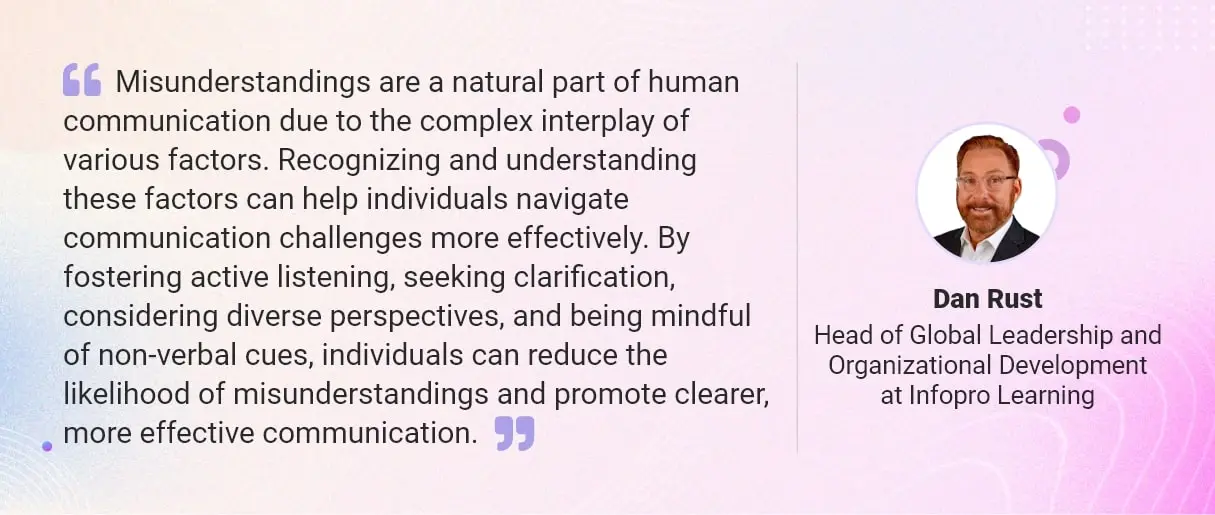Misunderstandings are an increasingly common occurrence in workplace communication. We all perceive the world through our own unique lens shaped by our experiences, beliefs, values, and cultural background. These differences in perception can lead to misinterpretation of verbal and non-verbal cues, as well as the intended meaning behind messages. Add to this the sense of overwhelm that comes from a seemingly endless stream of emails, text messages, meetings, conversations, reports to read, presentations to absorb, people to listen to — and it is no wonder that so much MIS-communication occurs.
People often make assumptions based on their past experiences or preconceived notions about others. These assumptions can cloud their understanding and prevent them from accurately grasping the intended message. Jumping to conclusions without seeking clarification can lead to misunderstandings.
Communication barriers, such as language barriers, technical jargon, or unfamiliar terminology, can hinder effective communication. When individuals lack a common language or struggle to understand specialized terminology, misunderstandings are more likely to occur.
Non-verbal cues, including facial expressions, body language, and tone of voice, play a significant role in communication. However, these cues can be open to interpretation and vary across cultures and individuals. Misinterpreting non-verbal signals can lead to misunderstandings, as the intended meaning may not align with the perceived meaning.
In addition, emotions play a significant role in communication. Strong emotions, such as anger, stress, or fear, can impact how individuals interpret messages, leading to biased understanding or reactive responses. Emotional states can interfere with effective communication and contribute to misunderstandings.

All of this makes it important that each of us fully “owns” the clarity of our communication. When we take responsibility for our communication, we understand that it is our duty to convey our thoughts, ideas, and intentions clearly. We recognize that others may not be able to read our minds, and it is our responsibility to express ourselves in a manner that is easily understood.
Taking responsibility for clear communication means being present and fully engaged when others are speaking. Avoid interrupting, make eye contact, and actively listen to understand their perspective. By practicing active listening, we create a more open and receptive environment for effective communication.
The words we choose can have a significant impact on how our message is received. Take responsibility for using words that are clear, concise, and respectful. Consider the context and the audience when framing your message. Strive for simplicity and avoid jargon or ambiguous language that may lead to confusion or misinterpretation.
Taking responsibility for clear communication involves actively seeking feedback from others. Encourage open dialogue by inviting questions, concerns, and feedback on your communication style. Be open to constructive criticism and use it as an opportunity for growth. If there is any ambiguity or confusion, take the initiative to seek clarification to ensure everyone is on the same page.
Recognize that each individual has unique communication preferences and styles. Taking total responsibility means adapting your communication style to meet the needs of others. Pay attention to non-verbal cues, listen to their preferred communication methods (e.g., email, face-to-face, etc.), and adjust your approach accordingly. Flexibility and adaptability foster stronger connections and understanding.
Sometimes, complex ideas or concepts can be better understood through visual aids or real-life examples. Taking responsibility for clear communication involves finding creative ways to illustrate your point. Incorporate visual aids, diagrams, or personal stories to enhance understanding and engage your audience effectively.
Reflect and Learn
Self-reflection is a powerful tool for personal growth and improvement in communication. Regularly assess your communication skills, identify areas for development, and seek opportunities for learning and growth. Actively seek resources, workshops, or training programs that can enhance your communication skills and help you become a more effective communicator.
Taking total responsibility for clear communication is an essential ingredient for building stronger connections and nurturing positive relationships. By recognizing the power of clarity, practicing active listening, choosing words mindfully, seeking feedback, adapting to others’ styles, using visual aids, and embracing empathy, we can significantly enhance our communication skills. As we strive to improve our own communication, we contribute to a more open, understanding, and harmonious environment where meaningful connections can flourish.



